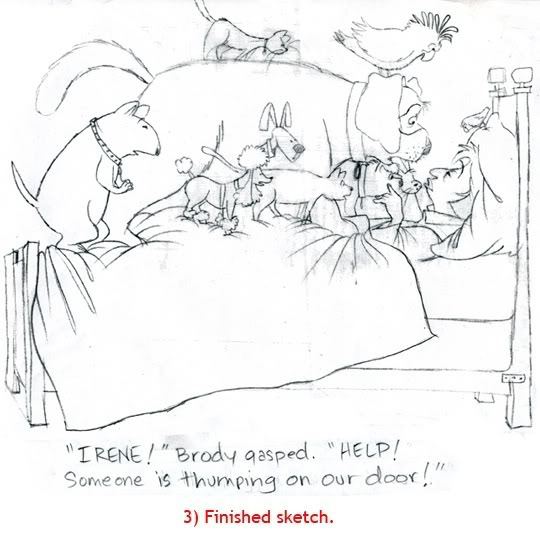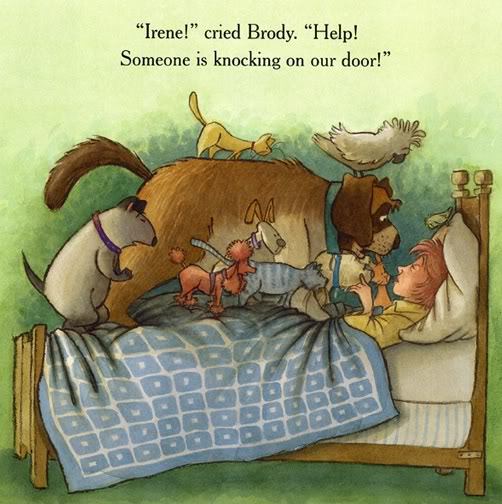Well, here we go with a back-to-back quack! (Click here if you missed Part 1.)
I hope you brought your appetite. For our second course with the multi-talented Jackie Urbanovic, we’ll be getting down to the nitty gritty detail of just how she makes her pictures. We’ll also hear about her consuming passion for comics, and for the first time ever on any blog, we’ll find out what she eats!
Quello again, Jackie. Could you describe how you did the illustrations for your two books featuring Max the duck?
First, I look at the big picture. I begin with thumbnail sketches — tiny sketches for every page being roughly 2″ x 3″ in size. I doodle the entire story in sequence. I begin this small so that I can quickly see the pacing and movement of the entire book at once. This allows me to plan where the climatic points will fall and to begin deciding what will be illustrated and what will be left to the words. It also lets me make sure that the story is fitting well into the 32 pages I have. I may do a set of thumbnails 2 or 3 times as a way to experiment and quickly try out different possibilities.
Second, I begin what’s called a book dummy. This is a larger set of sketches, folded like a book, at the same size as the book will be. The drawings are still doodles, but now there is room to see a bit more detail and to hand write the text in place. At this stage I make more changes because I can now see with more clarity if my original ideas work once they are full-sized.

Third, I work on creating my characters –deciding how they will look. This can be a few hours or a few days of work. I begin with looking at reference photos of the type of animals or people I’m working on and sketching them just to learn what they look like. Then I begin a process of caricaturing and simplifying them — exaggerating their features and making them into a personality a reader can recognize. I do a lot of experimenting. Then I mail these sketches as well as the book dummy to my editor, who looks them over. We discuss what works and what could be better.
Fourth, I do another set of revisions based on my editor’s responses. This is sometimes another book dummy, but most often it is a set of finished sketches with the revisions incorporated.

Fifth, after we’ve gone through all the revisions, I enlarge each sketch 40% and trace the image onto watercolor paper using a light table. The light table allows me to see through the paper. I enlarge the sketch so that I have room to put in more detail and to be more free with my brush strokes.
Sixth, I wet each piece of paper and secure it to a masonite board using a wide paper tape. Once the paper dries, it stretches out taut. Now, when I paint, the paper won’t buckle.

Seventh, I paint on 3 to 6 pages at a time, moving from one to the other. While one painting is drying, I can work on the next. This also gives me the chance to put a half finished painting aside for awhile when I’m not sure about how it’s working. If I leave it for an hour or two and come back to it, I can often see what needs to change.

Lastly, I re-draw over the light pencil outlines with a brown watercolor pencil, dipped in water, for my final outline. As I finish each painting, I cut it off the board and tape it to the wall. This way I can compare the colors and textures from the earlier paintings to the later ones, making sure they stay consistent.

Thanks so much! The average person merely sees the final product, not realizing how much detailed work and patience is involved in creating it. Let’s shift gears a little. The comic strip, Maggie, Inc., is a brilliant example of your passion for the genre. Did you draw comics/cartoons as a child? What were some of your favorite comic books? Would you like to do a graphic novel someday?
I love doing the Maggie, Inc., comic strip. There’s so much fodder for ideas and humor in my everyday life and that of my self-employed friends. My friend, Michelle Massman, came up with the idea and everyone I knew shared their stories with me. Yes, I drew cartoons as a child. I even created my own comic strips. I loved reading Uncle Scrooge comics the best. I also enjoyed reading Val, Archie, Batman, Superman, The Phantom — and I adored Mad Magazine. I also admired the drawing on the comic strips Pogo and Lil’ Abner, but I couldn’t understand the stories. A dear friend, Steve Thompson, brought those strips and others to my attention again as an adult. (He is the official Pogo historian and publishes the Fort Mudge Most, the Pogo/Walt Kelly fan magazine.)

I still read comics, comic strips and graphic novels. Here’s a partial list of my current faves:
Scary Grandmother by Jill Thompson
Elfquest by Wendy and Richard Pini
Howard the Duck by Steve Gerber
Groo the Warrior by Sergio Aragones
Usagi Yojimbo books by Stan Sakai
The Asterix books by Goscinny and Udzero
Nausicaa (and any books or films) by Miyazaki
Calvin and Hobbes by Bill Watterson
Mutts by Patrick McDonnell
Zits by Scott and Borgman
The cartoons and books of Jules Feiffer, Shel Silverstein, William Steig, Sempe, Posy Simmonds, Carol Lay, Peter Kruger, and Ronald Searle . . . and old comic strips: Gasoline Alley, Pogo, Little Nemo, Krazy Kat, Polly and her Pals.
My childhood dream was to become a comic book artist. I didn’t stray too far from that original dream, as picture books are a similar way to tell stories. And I would love to do a graphic novel someday.
This is so fascinating to me. Of course I read some comics as a child, but I am learning now about an entire industry that is exploding with exciting innovation and unleashed creativity. Speaking of innovation, Max the duck’s cooking has been described as creative and experimental. Yesterday you mentioned your love of cooking. Please describe your fondest food-related memory from childhood.
I love to cook and eat! I love discovering new foods and new recipes. I enjoy listening to the Splendid Table on NPR. I’d like to travel more just to sample the cuisine of many different cultures. And I’m fascinated with the politics of food and food production.
All of the women in my family are and have been tremendous cooks. My mother and grandmother grew their own vegetables and made many things from scratch: pickles, horseradish, raisin bread, kugelis, sausage, jams, coconut cream pie. I remember my mom and grandma both used to cook chicken with potatoes and carrots in a shallow pot with a little water. It would cook slowly on the stove all day until everything was very soft. And the smell in the house was absolute heaven.
Okay, my mouth is officially watering, and I’m growing weak at the mention of coconut cream pie. Describe your favorite meal. Is there one particular food that inspires your best work?
My favorite meal . . . hmmm, that’s like asking me my favorite book. Don’t get me started! Let’s see — I love a good spinach pie with a side of tabouli along with some feta cheese and olives. Or something Thai or Vietnamese, or a good deli sandwich with pickles and fries, or, I could go on and on. Eating anything I really enjoy inspires me, especially when I can eat it with my family or friends. And while I’m not sure Gobstoppers inspire my best art, I do munch on them constantly while I work.
What can you tell us about the recipe you’re sharing today?
I recently experienced this recipe from my cousins Tomas and Jen. It’s a Lithuanian dish. It appeals to me because it harks back to my heritage. Had I seen it in a cookbook I would NEVER tried making it because it was such an odd combination of foods. But, fortunately, they brought the dish to my house first and I absolutely loved it. I guarantee it tastes much better than it sounds!
TOMAS AND JEN’S (AND NOW, JACKIE’S) FAMOUS COLD BEET SALAD
4 cans beets
1/2 jar dill pickles
1 can white beans or chickpeas
small red onion
mayonnaise to taste
Chop the beets, pickles and onion into small pieces. Mix with beans and mayonnaise. Serve cold.

Thank you so much, Jackie, for sharing this interesting, insightful, and wholly satisfying two course meal with us. Where else could we have gotten beets and gobstoppers on the same plate? It’s been great learning about you and your creative process!
For info on school visits and some of the books Jackie has illustrated for other authors, visit her website.
If you’d like to learn more about Jackie’s comic strip, Maggie, Inc., click here.
For a cool interview with Jackie’s mentor, Jane Resh Thomas, click here.
**All spreads posted by permission, © 2008 Jackie Urbanovic, All Rights Reserved.

Beets! You made my day. I am SO going to make this.
And thanks for all the notes and pictures of Jackie’s process. I love seeing that transformation.
LikeLike
Fantastic interview! Thank you so much for having Jackie on your blog!
LikeLike
Wow, her illos just jump off the page, don’t they?
LikeLike
Great post, Jama! I love seeing the evolution of art like that. Fascinating.
LikeLike
Oops, that was my comment earlier. Sorry I forgot to sign in.
barbara
LikeLike
like a typical bum artist I am…
I just “looked at the picture” –real busy at work here– but WOW! COOL! YEAH!
LikeLike
When I saw Jackie’s recipe, I immediately thought of you! But I’m a little puzzled. You’ve professed your love of beets, yet you also said that things with double “ee’s,” like eels and bees, freak you out.
LikeLike
Glad you enjoyed it. Jackie was SO generous with her time in responding to my questions and providing all these great photos. I’ve never had gobstoppers, have you?
LikeLike
They sure do. You MUST see DUCK SOUP! There is so much humor and energy in every illustration. Her pictures literally vibrate with intense emotion . . .
LikeLike
I love seeing that process too, since I can barely draw stick figures.
LikeLike
Re: like a typical bum artist I am…
Glad you liked what you saw :)!
LikeLike
Yes, but I also like trEEs and things that are frEE. Maybe only animals with EEs freak me out? I’m just a complicated person, now aren’t I? 🙂
LikeLike
liked what you saw
I love seeing processes and her’s rock!
LikeLike
I have not had gobstoppers, but my younger daughter has. Not sure they were a favorite! The beet salad sounds good, I wonder if those were pickled beets or just plain ol’ canned beets?
LikeLike
You are extrEEmly complicated. I think the best thing to do would be to give up beets.
LikeLike
I think plain canned beets, since the recipe calls for pickles anyway. I think I may just have to try some gobstoppers (research, you know).
LikeLike
I shall try with plain canned beets. Good luck with the gobstoppers! 😀
LikeLike
Oooo, I like this illo-type lesson. I’m an illustrator-in-progress, so this was very helpful.
Thanks 🙂
LikeLike
I enjoyed seeing the way book illustrations evolve. Thanks for the sneak peek.
LikeLike
Thanks for stopping by to read. Will look forward to seeing your illos somedays soon!
LikeLike
You’re very welcome. I am endlessly fascinated with how different artists work. With Jackie, I learned about how her comic/cartoon passion informs her children’s books. This is an especially exciting time for picture books, with new forms evolving, like Brian Selznick’s illustrated novel, Hugo Cabret. Comics, which were definitely not considered literary when I was young, are now gaining new respect. Graphic novels are exploding. Did you ever think you could find anything like it in the library before?
LikeLike
Jackie is soooo nice! I’m so glad to see her process.
Thanks for a great interview, Jama!
LikeLike
So glad you enjoyed reading the interview. You’re absolutely right –Jackie is the best!
LikeLike
Wahoo! Great interview. And my girls and I read Duck Soup today, too!
jules, 7-Imp
LikeLike
Wasn’t it hilarious? I actually laughed out loud when I first read it. The characters’ expressions are SO funny :).
LikeLike